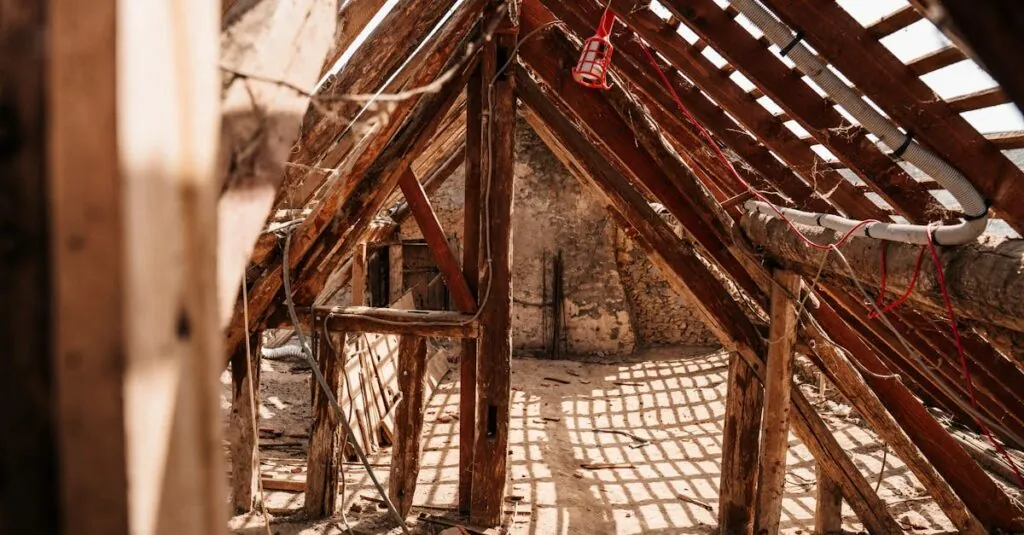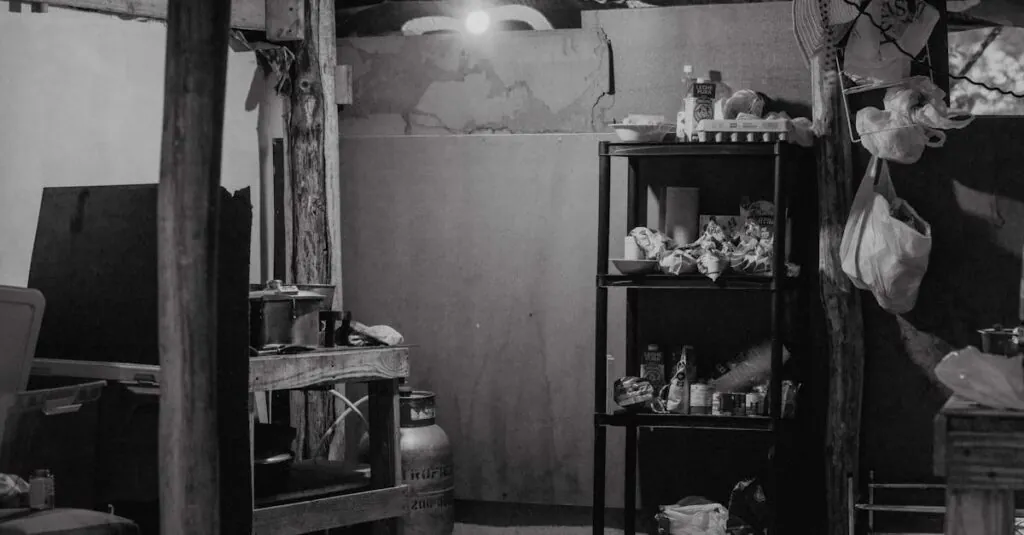Table of Contents
ToggleFraming repair might not sound like the most thrilling topic, but it’s the unsung hero of home improvement. Imagine a world where your walls stand tall and straight, not looking like they’ve just survived a wrestling match. When frames start to sag or bow, it’s not just an eyesore; it’s a call for help.
Understanding Framing Repair
Framing repair addresses structural issues that affect a home’s integrity and aesthetic. Maintaining proper framing ensures longevity and safety in residential properties.
What Is Framing Repair?
Framing repair involves fixing damaged or misaligned structural elements, including studs, joists, and beams. These components support the weight of walls and ceilings, playing a vital role in a home’s overall stability. When framing becomes compromised due to moisture, pests, or age, it affects more than just appearance. Effective repair often requires assessment, removal of affected sections, and replacement with new materials.
Importance of Framing Repair
Framing repair significantly impacts a home’s structural integrity and value. Unaddressed framing issues can lead to further damage, including wall cracks and roof sagging. Additionally, proper framing maintenance enhances energy efficiency by preventing air leaks and insulation gaps. Addressing these repairs allows for timely corrections that safeguard investment and ensure a safe living environment. Regular inspections can identify problems early, preventing costly repairs in the long run.
Types of Framing Repair
Framing repair includes two main categories: structural framing repair and non-structural framing repair. Each type addresses specific issues and contributes to the overall integrity of a home.
Structural Framing Repair
Structural framing repair focuses on critical components that uphold a building’s stability. It commonly involves repairing or replacing damaged studs, joists, or beams. Identifying problems early is essential; misaligned or bowed structures can lead to significant safety hazards. For instance, a compromised beam might affect the load-bearing capacity, resulting in further structural damage. Experienced professionals assess the extent of the damage and replace or reinforce materials. Additionally, this type of repair often requires compliance with building codes to ensure safety and legality.
Non-Structural Framing Repair
Non-structural framing repair deals with cosmetic issues that do not impact overall stability. It often includes fixing minor damage to walls, such as nail pops or small cracks. Addressing these issues promptly prevents further deterioration. Techniques may involve patching drywall or repainting areas to restore aesthetics without altering the framework. While these repairs seem less critical, they still maintain visual appeal and prevent problems from escalating. Regular maintenance helps preserve the home’s appearance and value, ensuring that non-structural damage does not become a more significant concern.
Common Techniques in Framing Repair
Framing repair involves specific techniques that ensure homes remain stable and visually appealing. Understanding these methods can help homeowners effectively address issues as they arise.
Tools Needed for Framing Repair
Basic tools facilitate effective framing repair. A hammer proves essential for driving nails into wood. Moreover, a level ensures walls and structures maintain proper alignment. Screwdrivers assist with securing screws, while a saw allows for precise cuts on wooden materials. A measuring tape helps accurately gauge distances and dimensions. Lastly, a square provides right angles, ensuring joints and corners remain structurally sound.
Step-by-Step Process
A methodical approach streamlines framing repair. First, assess the damage and identify the root cause. Next, make accurate measurements to prepare for new materials. Remove damaged elements with care to avoid further damage to surrounding structures. Then, install replacement pieces, ensuring proper alignment using a level. Secure the new framing with nails or screws for stability. Finally, inspect the repairs to confirm everything meets structural standards. Regular checks and maintenance keep the framing secure and effective long-term.
Challenges in Framing Repair
Framing repair poses various challenges, especially in identifying and addressing damage effectively.
Identifying Damage
Recognizing signs of damage early is essential for timely repairs. Inspect walls for visible cracks or bowing, as these indicators often reveal underlying framing issues. Attention should be paid to doors and windows that stick, which may point to misaligned frames. Uneven floors also signify potential problems within the structure. Performing regular assessments allows homeowners to catch issues before they escalate. Knowledge of common damage types, such as moisture-related warping or insect infestations, enhances the ability to detect problems promptly.
Addressing Complications
Complications often arise during the repair process, particularly when structural elements are compromised. Encountering hidden damage can lead to unexpected challenges, requiring careful assessment and planning. The alignment of new elements with existing structures becomes crucial; ensuring a seamless fit is pivotal for overall stability. Additional complications may include dealing with outdated building codes or adjusting to changing environmental conditions. Skilled professionals typically recommend adhering to established repair techniques to mitigate potential issues. Maintaining clear communication throughout the repair process aids in addressing concerns and achieving successful outcomes.
Framing repair is an essential aspect of home maintenance that shouldn’t be overlooked. By addressing both structural and non-structural issues, homeowners can protect their investment and ensure a safe living environment. Regular inspections and timely repairs not only enhance the home’s aesthetic appeal but also contribute to its overall stability and energy efficiency.
Understanding the importance of framing repair allows homeowners to take proactive measures, preventing small issues from escalating into significant problems. With the right tools and techniques, anyone can tackle framing repairs effectively, ensuring their home remains safe and visually appealing for years to come.





